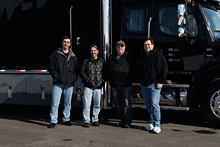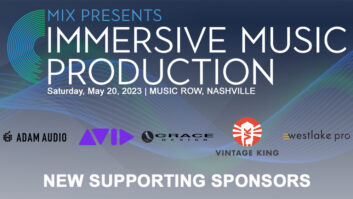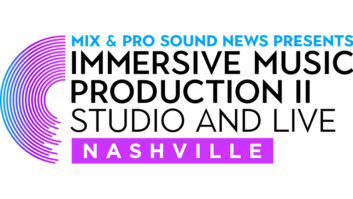
Music Mix Mobile partners, from left: Joel Singer, Mitch Maketansky, John Harris, Jay Vicari
The Music Mix Mobile remote/broadcast audio facility (M3) went online in July of ’08 sporting a brand-new state-of-the-art truck and flight-pack systems, all equipped with full-blown Pro Tools recorders and mixers, D-Command/D-Control surfaces, Genelec DSP surround monitoring and 120 channels of Grace remote mic preamps. The facility is owned and operated by veteran A-list engineers John Harris, Mitch Maketansky, Joel Singer and Jay Vicari—four friends who have been at this business for years, capturing, mixing and broadcasting everything from club shows, stadium concerts and major music award shows such as The Grammy Awards, Rock Hall Inductions, Country Music Awards, Live Earth, Live 8, VH1 Storytellers, and various MTV Video Music shows.
The following Q&A expands on “Music Mix Mobile—New Truck In Town” from Mix magazine’s February 2009 issue.
Some of you came to this new business from working with Effanel Music. Tell me how the idea for Music Mix Mobile developed.
John Harris and I had worked for the company, Jay freelanced for Effanel and Mitch was a past client who had used the company for events. In 2002, I built a remote facility in the Midwest, OnSite Recording Services. It featured a very powerful smaller truck built around the then-new [Yamaha] DM2000 and 48-track hard disk recorders. At that point, nothing in the market existed like this truck; it was a totally new type of remote model. John Harris and Randy Ezratty contacted me to see if I had an interest in becoming part of Effanel Music, as their business model needed some re-invention. It made sense, so I joined the company in 2003 moved back to the East Coast and became a member of the company. Shortly after, Randy (former owner of Effanel) asked if John and I would be interested in purchasing the company from him, to which we said yes. Unfortunately his timetable for sale and ours to purchase were a bit skewed, so we backed away, and he went looking for someone else to buy the company. He found XM Satellite Radio.
Since I still owned the OSR truck, he asked if I would be willing to sell it as part of his deal to XM. It seemed like this was a great plan: XM Satellite was an up and coming company involved in music broadcast events, and the plan was we would be doing a lot of live music for them. John and I both agreed—“This could be good, let’s have at it.” But the first year ended, and still not much work for XM; and the second year ended, and still not much work for XM. And the third, fourth—well, I think you get the picture. We were still working for many of the same clients we had before with no real change except for now, we were part of a publicly traded corporate machine with its benefits and drawbacks.
Then the other shoe fell and the merger was announced—XM and Sirius. As part of the initial process, we received paperwork regarding our severance packages should our jobs be eliminated as part of the merger. I remember having coffee with John and saying, “I’ve got a bad feeling about this.” With this on the horizon and the uncertainty of our positions in this new company, I began to think about options. And to boot, as the merger dragged on we were getting messages from people above us that perhaps this wasn’t what we signed on for in the beginning and we may want to consider other options.
So, John and I continued to chat about possibilities. We made some tough decisions, and in April of ’08 announced our departure from XM. As it happened, we had two very close friends that were kind of in similar positions. They were looking for a change and something solid and exciting to become a part of. Mitch Maketansky, who was a past client, but also a long-term friend, had a great interest in what we were doing. He had done A&E’s Live by Request, Woodstock ’94 and ’99, Live Earth, Live 8 and hundreds of other shows with us and is a great audio producer, so we thought this would be a really wonderful addition to the company. I’m technical, John’s the mixer, and then Mitch. The final piece to the puzzle was Jay Vicari, who is John’s counterpart in the broadcast mixing world. Jay’s mixed the Grammy Awards, MTV Movie Awards, MTV Video Music Awards, many HBO Music Productions, VH1 Storytellers and countless other shows and releases. He’s also been Saturday Night Live’s music mixer for the past 15 years. He said to us, “I’m looking right now for something solid to get involved in.”
So, we all started working on this new company. We developed a business plan, acquired bank financing and built this new company. It was a vision that came from everything we’ve done over the course of many, many years. John had been with Effanel for over 20 years and had a great feel for what was tried and tested. I had been doing this for a good many years and also knew how we could incorporate out-of-the-box technology and thinking into this venture. Jay had worked on many different trucks and offered some great suggestions through his experiences, and Mitch brought the view of what a client booking a facility required. This was all great and valuable input. We wanted to do this right and not be adapting or re-building as we went along. We embraced the phrase, “Anything worth doing is worth overdoing.”

Music Mix Mobile’s 2008 Freightliner M2-112 truck
We purchased a brand-new 2008 Freightliner M2-112 sleeper chassis, a 50,000-pound GVW long-haul truck. We painstakingly designed the space down to the last detail and had a proven facilities builder—Boulevard Body Works from New Jersey—fabricate it all. We built in more than enough air and ventilation, more than enough power, more than enough of everything, and then put in an electronics package that no one else in the U.S. had attempted before. All with one thing in mind: audio and workflow first.

Music Mix Mobile’s rack system
We knew the front end [microphone preamps] was going to be one of the most important choices we made. We wanted the best of what would fit our criteria. They needed to sound amazing, have remote control, robust design and A to D conversion inside the unit. After much testing and careful analysis of recordings, we chose Grace Designs. It was the most musical preamp of the ones tested, and had all of the features we required. We built (two) racks, 112 channels total for the front end of this new system. All have the Grace A to D digital option that allows AES connection to our RME ADI-6432 MADI converters. We added in Whirlwind 58-channel Transformer splitters and custom panels to make interconnect to the outside world easy.
What else would you say you “overdid” for this truck?
Everything from the stage is on fiber optics. There are multiple fiber strands and plenty of redundancy. Each of our preamp racks output 56 channels digital [AES/MADI] and line level analog, while the third rack is capable of 56 channels of mic- or line-level conversion to MADI. We also designed two Pro Tools HD6 recording systems—master and safety. We are able to record over 168 channels on each of the recorder machines. The mixer system is a completely separate PT HD6 with boatloads of IO. This way we aren’t recording on the desk; it’s like a traditional mixing environment.
Now I am not saying we don’t ever record on the desk. Recently we had to do a bunch of pre-tapes that would be put back onto a playback system for a live show. To make it easier and quicker, we built a record session on the console system, recorded the elements, did a quick edit/remix and played it back out to the video truck. Very fast, very efficient. The whole point is, we don’t have to specially build or modify systems to accommodate any type of show. The truck and flight packs arrive the same way and work the same way every time.
That’s more than any truck can currently do. When we finished M3 it immediately got tested. We took the system out to record Billy Joel at Hershey Park, Penn., and Shea Stadium. We had to record over 114 channels, and at that point if you brought in any other truck in the market, they couldn’t have accommodated it as easily as we did. They would have to augment their systems with more cabling, more recorders, more of this, and more that. We did it on two fiber-optic runs from a half a mile away.
We have a D-Control surface in M3, D Command in our M1 flight packs and D-Command in our fixed studio. All have identical plug in packages with full Waves Mercury Bundles, TC Reverb Bundles, McDSP Emerald Bundles, and Sound Toys Bundles—lots and lots of plug-in options. We do this so when you work on any of our systems, you can move to any other with zero problems. It is all about workflow. We wanted to do shows (live or recorded) and have either Jay or John mixing in the truck, and then either one of them remixing it for broadcast or post. We’ve already done shows where we were recording for next-day broadcast with John mixing. We finished the recording at 11 p.m., sent the drives via sneaker-net to our studio, Jay started editing and mixing and handed back audio [5.1 and stereo] to the post house via our FTP site by noon the next day so it could be married and put on the air that evening. You get a much better product than you’ve been able to get before and don’t have to beat up the mixer [to where he would be] working a very long day or keeping the truck on-site at a greater cost.
What other projects have you done with the new systems?
We spent two weeks recording Elvis Costello’s Spectacle show for the Sundance channel, at the Apollo Theatre. We took the sessions back to our studio and remixed it for broadcast handing the necessary elements to Sue Pelino at Creative Group for post. It all came back like we were still sitting in the truck. It was touch-up mixing, not start it over from scratch, which is great because you don’t lose any time. The workflow is brilliant, and this translates to outside mixers also. These sessions can be taken back to most any Pro Tools system and continued.
It’s the same thing with all of our flight packs. We did pre-tapes this year for Thanksgiving and New Year’s Eve shows. We would take our portable to record and build a rough—or sometimes not that rough—mix, take it back to the studio, boot it up and just touch it up. Saves the client an immense amount of time and money.

What is different about what you offer with the flight pack rig vs. the truck?
Sometimes you can’t use a truck due to space constraints. For some recent NBC records, we were shooting on the roof garden at Fifth Avenue, across form St. Pat’s church. You can’t park a truck anywhere near there. You have to bring in a portable video system and a portable recording system. A lot of people think the portable system is less of a system than the truck. It isn’t. They are both two extremely powerful systems built for different purposes.
In other words, it helps to have an additional system, especially in cases where logistics make it difficult to bring the truck.
Exactly. But also when there is a need for a second truck. We just finished the Kids Inaugural for Disney Channel at the Verizon Center in Washington, D.C. The 90-minute show went way too fast to be done with one mixing room. The bands are on a turntable, and changes happen with 90 seconds between each. And since this is a live-to-air event, you have to be line-checked and ready as soon as the platter turns. So we brought the truck and a flight pack system, which we set up in a Green Room. This way, you don’t lose anything and it’s amazingly comfortable for the mixers. You either have 12 cases that load into a room, or a 40-foot truck.
When did your business officially go online?
We actually started doing flight pack shows as early as May of 2008. The first truck show was July 7th in Hershey, Penn., with Billy Joel. We did three days of rehearsals and one stadium show there with him. As we were packing to go home for a few days between Hershey and Shea we got a call from the Bon Jovi people to mix and record a show from the Great Lawn in Central Park for a Fox Sports All-Star event. A day after that, we moved the truck to Shea Stadium and did “The Final Play at Shea” for Billy.
So, it started off with a bang. It’s cool to think the first shows for this truck were Billy Joel and Bon Jovi. It’s still pretty surreal.
What else do you want people to know about the new facility?
From an electronics level, the truck has 5.1 Genelec DSP speakers, Dolby processors, HHB Dual CD Recorders, Z-Sys AES Routers, Apogee Clocking, hard disk video recording, a 40-inch SDI-HD LCD in the control room, and a host of other equipment to make the remote process easier and more comfortable. The truck is also really easy to set up and work. There is no re-invention on site. From the time we arrive to the time we leave it’s a well-oiled machine.

Did you design the acoustics of the truck yourselves?
John designed the control room acoustics with the assistance of Ty Moyer at Acoustic Sciences Corp. in Oregon. All of the interior acoustics were built by ASC and installed to John’s spec. They did a great job, and the imaging and sound is amazing.
Do you feel confident that there’s plenty of business to go around in your field at the moment?
The [remote] business has shifted away from recording concerts, even though we do those occasionally. By coincidence, we just recorded Beck for three nights at the United Palace in Harlem. He had a vision for the way he wanted it recorded, so we brought in quite a few vintage Neve 1073 and 1084 preamps along with a few API lunchbox pre’s. Again, since we are a digital company we converted all signal through our line level 56-channel rack [Apogee AD16X converters]. But those gigs don’t often happen. We do much more tele-production.
In general, this business is still based on people, not on hardware. We felt that when we rolled the dice back in April, clients—past, present and future—would want to work with who they have a comfort level with and has a track record for getting the job done. And we’ve been proven right about a lot of what we thought from the start. We found out over the holidays that Sirius made a decision to lay off everyone in our division, which would have included us. John and I would have had a severance package, but what good does a severance package do when you do something so specialized? It’s not like you can go out and build a truck overnight. It took us five months to build this truck completely, and on top of that, go try to get funding today.
We made a solid investment in each other doing something we know well. And I have to tell you that’s a much more solid investment then the stock market right now. We’re not moving too far outside the box right now, and we’re comfortable that in the New York market, on this side of the country, we are one of the world-class [remote] recording facilities.
So you’re feeling good about your decision…
Absolutely. Keep in mind that we all have families and did something that was based on our their best interests. I have four kids, John has one, Mitch has one, and Jay has four. We are tying to do what we know best and that’s remote recording and broadcast. Times are tough, but from the start, we were minding our Ps and Qs and have a great business plan. We occupy a 3,000-square-foot shop in Frenchtown, N.J., where we keep our trucks, and do all of our tech work. We’ve done this the right way. I have three of the best partners who all share the same zest for this business and this unique opportunity. We are constantly looking into the future, and looking forward to the future.
Barbara Schultz is the copy chief for Mix. For more on Music Mix Mobile, visit www.musicmixmobile.com and read Janice Brown’s story “The Changing Landscape of Remote Recording” from Mix’s September 2008 issue.







